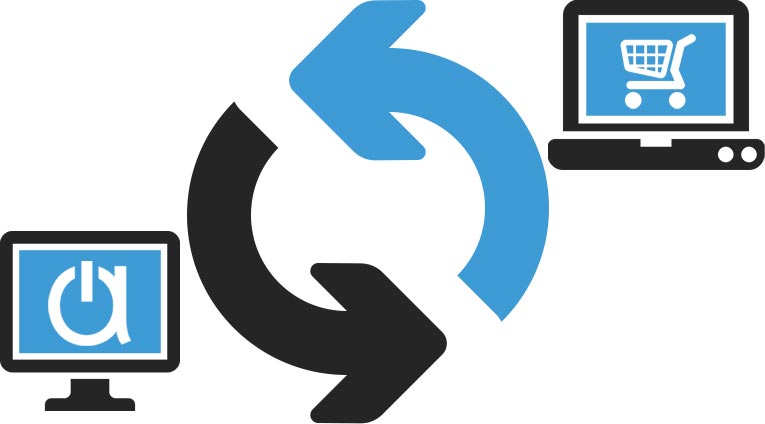eCommerce Inventory Integration
Built For


eCommerce inventory integration
By solving the complex situation of managing multiple sales channels, inventory integration software improves order and inventory management and greater visibility across all channels.
Acctivate’s eCommerce inventory integration software solution pulls multiple channels together, and while the business benefits are many, the one frequently cited at the top of the list is a sense of relief from the simplified business operations.
Does webstore and ecommerce inventory management have you feeling overwhelmed?
Some days does it feel like you are running two (or more) businesses – one for your web store and one for your main business?
It’s a common situation. Businesses select a best-in-class web store platform – and are happy with it – but end up running two systems.
As ecommerce continues to grow, so do the opportunities and challenges…
Separate systems: Running a non-integrated web store and operational systems for handling the rest of the business can result in issues with inventory availability, order tracking, and customer service inquiries.
Order fulfillment: Pick accuracy, on-time shipping, and real-time tracking are critical to customer satisfaction. No longer a nice to have – advanced order fulfillment capabilities that exceed those offered by web store platforms are required for online customer satisfaction.
Multi-channel: Customers may purchase from a company across multiple channels – online, offline, by phone, fax, mail order, telephone orders, and/or from a catalog – but they expect their orders and inquiries to be handled the same, regardless of how or where they purchased.
What if you could keep your web store software but consolidate all back office information and manage customers across all channels into one system? You can.
Ecommerce inventory management software allows you to manage all your channels, inventory and your entire business in one place with…
Automated synchronization
Acctivate web store and ecommerce integration enables automated synchronization of orders, tracking information, product availability and customers between Acctivate and the web store.
Companies can accommodate order volume by configuring a web store sync to run automatically at time intervals of every 5, 15, 30 or 60 minutes.

Acctivate ecommerce inventory management software seamlessly integrates with best in class, well-known web store platforms including:
Don’t see your web store listed? Contact us – we are actively developing integrations with other web store platforms.
Ecommerce inventory management software: Key features
Acctivate ecommerce inventory management software helps you gain control of your inventory across all channels, in every warehouse, with access from anywhere, anytime. Acctivate enables:
- Orders imported from websites are handled as all other Acctivate orders with system-wide access to order, inventory, product, warehouse, credit, or customer service information, history, reporting, notes, alerts and activity management.
- Multi-channel customer management – online, offline, mail order, telephone order, catalog
- B2B or B2C capabilities
- All product attributes available online including images and descriptions.
- Real-time credit card payment processing that is fully integrated with Acctivate with stored/recurring charge capabilities or credit card processing via existing processor with Acctivate data synchronization for storing order, customer service, and payment data.
- Simple, automated order synchronization between Acctivate and web store.
- Default fields can be set in Acctivate for fields not supplied by the web store.
- Batch processing of web orders allows for efficient processing.
- Ability to set primary warehouse with an override to alternate warehouses.
- Promotion codes
- FedEx, UPS, USPS and DHL shipping integration with tracking information available to customers via email.
- Backorders or pending orders can be released for shipment anytime in the future.
- Web store items can be drop shipped with the click of a button.
- 3PL support
- Direct integration with QuickBooks
- Custom reports utilizing Crystal Reports®
- User-level permission management
Adding power to your ecommerce operations and web store
Integrating your web store with affordable, award-winning Acctivate delivers company-wide functionality to your business that will help you manage and coordinate the resources, information, and functions across your company — locally and globally, today and tomorrow.
Integrate your web store and ecommerce operations with Inventory management

Acctivate is the premier solution for inventory management and warehousing, with advanced features such as purchasing, multi-location warehouse management, barcoding, kitting, assemblies, and lot and serial number tracking and… inventory availability is synchronized between Acctivate and the web store automatically.
Integrate your web store and ecommerce operations with multi-channel customer service

Acctivate enables multi-channel order and customer management across all channels and equips the entire company with easy to access and use customer service tools.
Orders imported from the web store are handled as all other Acctivate orders with system-wide access to order, inventory, product, warehouse, credit, or customer service information, history, reporting, notes, alerts and activity management.
Integrate your web store and ecommerce operations with order fulfillment
Acctivate’s picking and shipping tools are designed to reduce errors, eliminate bottlenecks, optimize worker productivity and assist in the process of satisfying customers time and again.
Outsource to 3PL or use drop ship for your orders? Acctivate supports companies that have chosen to outsource their warehousing and distribution operations to third-party logistics (3PL) providers and accommodates drop-shipments that go from your vendor directly to your customer.

Integrate your web store and ecommerce operations with tools to understand and grow your business
Acctivate brings your company together in a single system — management, purchasing, warehousing, sales, marketing, shipping, and customer service — increasing productivity and enabling real-time access and visibility across your entire business.
Acctivate’s customizable dashboards, decision support tools, custom report capabilities and business activity management tools enable managers to coordinate the resources, information, and functions across the company — locally and globally.
Integrate your web store and ecommerce operations without leaving QuickBooks
Just as Acctivate integrates with major web store solutions, Acctivate also integrates with QuickBooks, enabling users to gain advanced inventory and business management tools without leaving QuickBooks.
Call us at 817-870-1311
















